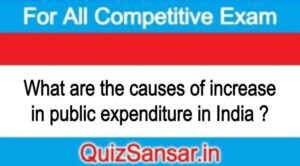
What are the causes of increase in public expenditure in India ?
What are the causes of increase in public expenditure in India ?
Ans.
Causes of Increase in Public Expenditure in India
Following factors account for the increase in public expenditure in India –
(1) Application of Wagner’s Law: According to Wagner, the main cause of increase in public expenditure is the multiplication of the activities. of the government. Since independence, both the development and non development activities of the government have considerably increased. Government expenditure has increased on account of the expansion of public sector. In order to promote welfare of the people, government has to spend large amounts on their merit wants, such as, construction of roads, parks etc. Public expenditure has also increased because of external factors.
(2) Increase in Population : Public expenditure has increased considerably because of the following tendencies found in India’s population:
Because of increase in population, average expenditure of the government has got to be increased even without increasing the quantum of services. As a result of increase in population, government is supposed to provide more services to the people. Thus, the government has to incur more expenditure. This rising population increases the liability of the government to provide for more educational facilities, civic amenities, employment opportunities and agricultural and industrial goods to the people. The corresponding increase in public expenditure is but natural.
(3) Increase in Social Services: States’ responsibility in respect of social services like, health and education, has also multiplied over time. Government of India aims at providing free and compulsory education to the millions in the age-group of 6-11 years under Five Year Plans. It has also added to rise in public expenditure.
In 1951, central government had spent Rs. 7.6 crore on education. In 2002-03, this expenditure increased to Rs. 3,044 crore. In 1960-61, state government had spent Rs. 196 crore on education, but in 2002-03 this expenditure increased to Rs. 28,289 crore. Government has to spend a lot on health and family welfare programmes. Also many programmes are underway to control infectious diseases like malaria, T. B., cholera, leprosy etc. With a view to providing all these facilities and services, public expenditure has increased constantly.
(4) Increase in Social Security and Social Welfare: Since independence, government has been providing many social security benefits to the workers and poor classes and social welfare facilities to scheduled castes and scheduled tribes. State governments have been spending a great deal on various facilities under social security measures, such as, pension, sickness allowance, maternity benefit, provident fund, insurance against accident, death compensation etc. Workers have been provided social security in India under Employees Provident Fund Act (1952). All this has led to increase in government expenditure. Roughly, 22 percent of country’s population consists of scheduled castes and scheduled tribes. Government spends huge funds on their social and economic welfare. Thus, expenditure on various social security and social welfare schemes also accounts for the enormous increase in public expenditure.
(5) Urbanisation : During the period of planning, proportion of urban population in India has increased noticeably. In 1951, just 17.3 percent of the total population lived in urban areas. This percentage increased to 27.8 in 2001. Urbanization of population leads to multiple increase in government expenditure. With increase in urban population, government expenditure on administration, police, transport, education etc, increases rapidly. Urbanization gives rise to housing problem as well. Assistance given for the construction of houses and other programmes has also added to the ever increasing public expenditure.
(6) Extension of Public Sector and Nationalization: Since independence, several important public services like railways, roads, transport, electricity, coal-mines, banking, air traffic, etc. have been nationalised. Many public services, like post and telegraph, telephone, roads, etc. have expanded in public sector. In 1951, an amount of Rs. 29 crore was invested in public sector industries. In 2001-02 it increased to Rs. 3,03,400 crore. Thus, public expenditure has also increased on account of expansion of public sector and nationalization of public utility services.
(7) Economic Planning: In order to achieve the objective of country’s economic development, government has adopted the technique of economic planning. Programme of economic planning was launched in 1951 in the country. Large amount of public expenditure is being incurred on these plans. Rs. 2,20,216 crore. Thus the total expenditure on the Seventh Plan was 110 times more than that of the First Plan. The public sector outlay for Tenth Plan was Rs. 15,25,639 crore. This has substantially added to the increase in public expenditure.
(8) Increase in Defence: Of the total expenditure of the central government, defence expenditure constitutes the biggest chunk, and it is this very chunk which has enormously risen over time. Danger of aggression from two neighbouring countries, China and Pakistan, always looms large. Defence of the country calls for the modernisation and expansion of all the three services army, navy and air force. Since independence many factories manufacturing military hardware, armaments, tanks, aeroplanes, ships, arms and ammunition, etc. have been established. In 1960-61, defence accounted for Rs. 283 crore out of the total expenditure, but after Chinese aggression in 1962, defence expenditure increased a great deal. In 2005-06, there was expenditure of Rs. 83,000 crore on defence. It represents 19 percent of the total expenditure on revenue account. Ever-rising expenditure on defence has greatly contributed to the increase in public expenditure.
(9) Civil Administration : Democratic set up of the country has also increased central and state governments’ expenditure on civil administration. Government has to spend large amount of money on such activities as police, law and order, collection of taxes, etc. In 1950-51, total outlay on this item was Rs. 43 crore but in 2005-06, state governments had to spend Rs. 13,354 crore and central government Rs. 33,585 crore on this very item. Increase in administrative expenditure also account for increase in total public expenditure.
(10) Growth of Fiscal System : In order to meet its revenue needs government has got to collect taxes and arrange for loans. Thus, it has to work out a comprehensive fiscal system. With the passage of time, this system has been expanding and expenditure on fiscal services increasing. In 2002-03, central, state governments and Union Territories had to spend Rs. 10,053 crore on this item.
(11) Interest: With a view to meet their expenditure on capital account, central and state governments are to borrow from public on a large scale. On account of increased amount of interest on these loans, public expenditure has tended to rise. In the year 1950-51, a sum of Rs. 82 crore was paid as interest on loans, and in 2005-06 the amount of interest payment increased to Rs. 2,08,379 crore.
(12) Establishment of Democracy: In free India, democratic form of government has been functioning. As a result of it, expenditure on parliament, legislative assemblies, legislative councils, ministries, governors and President’s secretariat, etc. has increased appreciably. It is another main reason of rise in public expenditure. Establishment of local self government and Panchayat Raj has also added to public expenditure.
(13) Membership of International Organisations: After World War II, many international organisations were set-up. India has been a member of all of these. Their membership entails financial obligations. On account of her membership of such world organisations as U.N.O., W.H.O., F.A.O., I.L.O, etc., public expenditure in India has increased very much. Besides, the government has to establish its embassies abroad. It has also added to public expenditure. Good deal of expenditure is also incurred on international conferences.
(14) Increase in Prices: Rising prices also account for the increase of public expenditure in India. Prices have been rising in India since 1956. Because of increased prices, government has to spend more in order to get the same amount of goods and services as before. Government employees have to be paid more salaries, more dearness allowance and more pension. Expenditure on development projects also increases.






